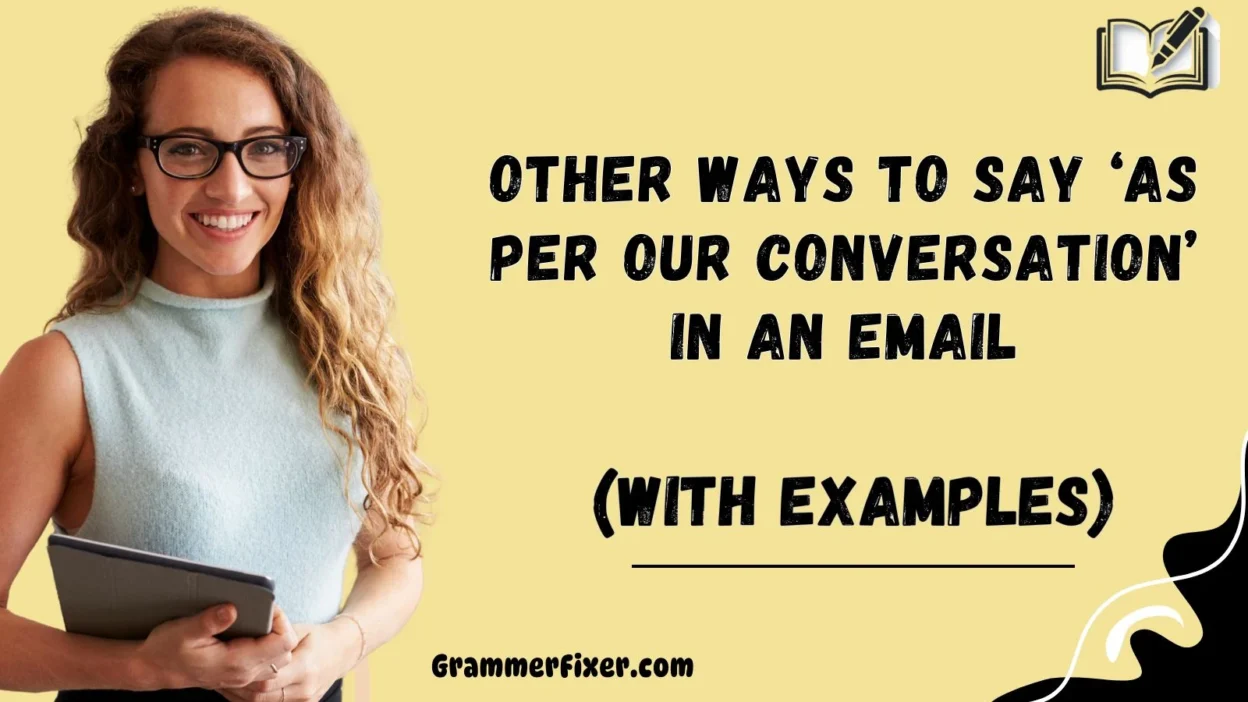Finding the right words in professional communication can make all the difference between sounding distant and coming across as warm, respectful, and thoughtful. While the phrase “As per our conversation” is common, it can sometimes feel too formal, repetitive, or even impersonal. That’s why exploring alternatives helps you connect more meaningfully with colleagues, clients, and business partners.
This guide lists 30 empathetic alternatives, along with explanations, scenarios, and tones—so your emails sound both professional and human.
What Does “As Per Our Conversation” Mean?
The phrase “As per our conversation” is typically used to reference something discussed earlier, whether in a call, meeting, or email. It signals that you’re following up on an agreement, clarification, or task.
When to Use “As Per Our Conversation”?
Use this phrase when you need to:
- Confirm details from a previous dialogue
- Reiterate expectations or agreements
- Provide clarity for a recipient
- Ensure shared understanding in professional contexts
Is It Professional/Polite to Say “As Per Our Conversation”?
Yes, it’s professional, but it can sound stiff or overly formal. That’s why many professionals prefer friendlier alternatives that still maintain clarity and respect.
Pros or Cons
Pros:
- Clear reference to earlier communication
- Professional tone
- Widely understood in workplace contexts
Cons:
- Can sound cold or impersonal
- May feel accusatory if overused
- Risks coming across as repetitive or cliché
1. As We Discussed
Meaning: Refers back to a prior talk.
Explanation: A softer, more conversational way to remind someone of earlier points.
Scenario Example:
“As we discussed, I’ve attached the revised proposal for your review.”
Best Use: Collaborative settings where both parties are on the same page.
Worst Use: When no actual discussion happened—it could make the recipient feel confused or accused.
Tone: Warm, conversational.
2. As Agreed
Meaning: Highlights a mutual decision or commitment.
Explanation: Useful for confirming what was decided during a prior meeting or call.
Scenario Example:
“As agreed, I’ll send over the final draft by Friday.”
Best Use: Confirming formal agreements, deadlines, or tasks.
Worst Use: When agreement wasn’t actually reached—can feel like forcing responsibility on the recipient.
Tone: Respectful, direct.
3. Following Our Conversation
Meaning: Signals continuation from a prior discussion.
Explanation: Smooth way to transition into action items from a past exchange.
Scenario Example:
“Following our conversation, here’s the updated project plan.”
Best Use: Professional follow-ups after meetings or calls.
Worst Use: Casual or social exchanges where the formality feels excessive.
Tone: Neutral, clear.
4. Based on What We Discussed
Meaning: Indicates that the action is rooted in prior dialogue.
Explanation: Good for showing logical connection between the past discussion and current actions.
Scenario Example:
“Based on what we discussed, I’ve adjusted the timelines accordingly.”
Best Use: Explaining changes or rationale for a decision.
Worst Use: When addressing sensitive topics—the phrasing may sound like you’re deflecting responsibility.
Tone: Supportive, explanatory.
5. In Line With Our Discussion
Meaning: Aligning with previously mentioned points.
Explanation: Implies that the current action matches what was talked about earlier.
Scenario Example:
“In line with our discussion, I’ve updated the budget spreadsheet.”
Best Use: Situations requiring alignment and consistency.
Worst Use: Informal settings—it may come across as too corporate or rigid.
Tone: Formal, professional.
6. To Clarify
Meaning: Used when you want to restate or simplify what was discussed earlier.
Explanation: Helpful for preventing misunderstandings and ensuring everyone is aligned.
Scenario Example:
“To clarify, we agreed that the final draft is due by Wednesday.”
Best Use: When confirming details that could be misunderstood.
Worst Use: When the recipient already feels certain—it might come across as patronizing.
Tone: Clear, precise, slightly formal.
7. As Promised
Meaning: Refers back to a commitment you made earlier.
Explanation: Shows reliability and accountability by reminding the recipient of your follow-through.
Scenario Example:
“As promised, I’ve attached the revised training materials.”
Best Use: When delivering on something you personally committed to.
Worst Use: When used in a way that pressures or guilt-trips the recipient (e.g., “As promised, you should have sent this already”).
Tone: Supportive, trustworthy.
8. According to Our Last Conversation
Meaning: Directly connects current information with your most recent dialogue.
Explanation: Good for referencing a very specific meeting, call, or chat.
Scenario Example:
“According to our last conversation, the next steps involve completing the draft by Friday.”
Best Use: Structured project or timeline updates.
Worst Use: When conversations were casual and not meant to be official—it may sound too formal.
Tone: Professional, factual.
9. Further to Our Meeting
Meaning: Expands on what was covered in a prior meeting.
Explanation: Signals that you’re adding context, follow-ups, or additional information.
Scenario Example:
“Further to our meeting yesterday, I’ve attached the financial summaries.”
Best Use: Formal communications with clients or stakeholders.
Worst Use: Informal or friendly chats—it can feel stiff and overly corporate.
Tone: Formal, courteous.
10. Within the Scope of Our Discussion
Meaning: Ties current actions or updates directly to the agreed-upon scope.
Explanation: Useful in project management where boundaries and deliverables are important.
Scenario Example:
“Within the scope of our discussion, I’ve finalized the tasks related to phase one.”
Best Use: Technical or project-focused emails.
Worst Use: Everyday interactions where the phrase feels overly technical or jargon-heavy.
Tone: Formal, structured, precise.
11. Just to Reiterate
Meaning: A gentle way of restating key points.
Explanation: Prevents miscommunication while keeping the tone collaborative.
Scenario Example:
“Just to reiterate, the marketing team will lead the campaign launch on Monday.”
Best Use: When you need to emphasize important details without sounding pushy.
Worst Use: Overused in every email—it could come across as condescending.
Tone: Gentle, clarifying.
12. As We Agreed Upon
Meaning: Restates a mutual agreement in a professional tone.
Explanation: Slightly more formal than “As agreed.”
Scenario Example:
“As we agreed upon, I’ve scheduled the training session for Thursday afternoon.”
Best Use: Confirming deliverables with clients or managers.
Worst Use: Casual internal updates—it can feel unnecessarily formal.
Tone: Formal, respectful.
13. After We Spoke
Meaning: References something that occurred following your previous discussion.
Explanation: Indicates progress or updates that came directly after a conversation.
Scenario Example:
“After we spoke, I contacted the vendor to confirm delivery timelines.”
Best Use: Progress updates.
Worst Use: Formal reports—sounds too conversational.
Tone: Friendly, approachable.
14. Here’s a Quick Recap
Meaning: Provides a summary of earlier points.
Explanation: Great for ensuring key ideas don’t get lost.
Scenario Example:
“Here’s a quick recap of what we decided during today’s call: timelines, budget, and next steps.”
Best Use: Email summaries for teams.
Worst Use: Very formal or legal correspondence—it may feel too casual.
Tone: Friendly, efficient.
15. Pursuant to Our Conversation
Meaning: A highly formal way of saying “in accordance with what we discussed.”
Explanation: Often used in legal, contractual, or compliance settings.
Scenario Example:
“Pursuant to our conversation, please find attached the signed agreement.”
Best Use: Legal or formal contractual communication.
Worst Use: Everyday workplace chats—sounds excessively rigid.
Tone: Very formal, legalistic.
16. Keeping Our Exchange in Mind
Meaning: References the earlier dialogue while showing consideration for what was shared.
Explanation: Conveys empathy and attentiveness, suggesting you’ve thoughtfully considered the conversation.
Scenario Example:
“Keeping our exchange in mind, I’ve revised the proposal to reflect your feedback.”
Best Use: When you want to show respect for the recipient’s input.
Worst Use: Highly formal settings—it may sound too casual or emotional.
Tone: Considerate, collaborative.
17. In Accordance With Our Discussion
Meaning: Formal expression meaning “in line with what we discussed.”
Explanation: Signals conformity and professionalism, common in business and official communication.
Scenario Example:
“In accordance with our discussion, the updated guidelines have been attached for your review.”
Best Use: Policy updates, compliance communication, or formal instructions.
Worst Use: Everyday casual emails—too stiff for regular use.
Tone: Formal, precise.
18. As We Touched Upon
Meaning: Refers to something briefly mentioned earlier.
Explanation: Softens the reminder, making it less directive and more conversational.
Scenario Example:
“As we touched upon in yesterday’s call, the budget adjustments are reflected in the attached file.”
Best Use: Gentle reminders.
Worst Use: When the issue was thoroughly discussed—sounds dismissive if misused.
Tone: Gentle, conversational.
19. As Previously Mentioned
Meaning: Highlights a point that has already been brought up.
Explanation: Useful when reinforcing details without starting the discussion over.
Scenario Example:
“As previously mentioned, the final draft will be submitted by end of the week.”
Best Use: Reiterating expectations clearly.
Worst Use: If overused, it may sound like you’re scolding the recipient for forgetting.
Tone: Neutral, firm.
20. Going Back to Our Conversation
Meaning: Brings attention back to earlier dialogue.
Explanation: Great for smoothly reintroducing a topic into the current context.
Scenario Example:
“Going back to our conversation, I wanted to confirm the updated deadline.”
Best Use: When reminding someone of a previously discussed detail.
Worst Use: High-stakes or sensitive topics—may feel too casual.
Tone: Friendly, approachable.
21. As Stated During Our Call
Meaning: Directly references a point made in a call.
Explanation: Works well when highlighting something specific said verbally.
Scenario Example:
“As stated during our call, I’ll be finalizing the draft by Thursday.”
Best Use: Clear reference to verbal communication.
Worst Use: In written-only exchanges—could confuse the recipient.
Tone: Professional, straightforward.
22. As Outlined in Our Meeting
Meaning: Refers to structured plans or points discussed in a meeting.
Explanation: Suggests that the following information comes directly from an official meeting.
Scenario Example:
“As outlined in our meeting, here’s the project timeline with assigned responsibilities.”
Best Use: Project management, team updates.
Worst Use: One-on-one informal chats—it may feel too formal.
Tone: Organized, professional.
23. Reiterating Our Key Points
Meaning: Re-emphasizes the main parts of a conversation.
Explanation: Ensures that the most important details are clear and not overlooked.
Scenario Example:
“Reiterating our key points, the budget must be finalized by next Friday.”
Best Use: Preventing misunderstandings in complex projects.
Worst Use: In overly casual emails—can sound unnecessary.
Tone: Clear, reinforcing.
24. In Reference to Our Discussion
Meaning: Directly points to a prior discussion as the basis for the message.
Explanation: A versatile phrase for professional follow-ups.
Scenario Example:
“In reference to our discussion, I’ve shared the updated training materials.”
Best Use: Formal or semi-formal communication.
Worst Use: When you want a softer or more collaborative tone.
Tone: Professional, neutral.
25. As Highlighted Earlier
Meaning: Draws attention back to a previously emphasized point.
Explanation: Useful when reminding someone of details you know were already noted.
Scenario Example:
“As highlighted earlier, the proposal deadline is set for Friday at noon.”
Best Use: Re-emphasizing deadlines or instructions.
Worst Use: If the recipient feels you’re repeating unnecessarily—it may sound like nagging.
Tone: Firm, direct.
26. Building on Our Conversation
Meaning: Suggests you are extending the discussion further.
Explanation: Positive and collaborative—it implies teamwork and shared growth.
Scenario Example:
“Building on our conversation, I’ve drafted some new ideas for the upcoming campaign.”
Best Use: Brainstorming, idea-sharing.
Worst Use: Strictly formal legal or contractual communication.
Tone: Collaborative, encouraging.
27. As We Agreed in Principle
Meaning: Suggests both parties came to a general agreement.
Explanation: Often used when final details may still be pending.
Scenario Example:
“As we agreed in principle, I’ll prepare the draft version of the contract.”
Best Use: Preliminary agreements, early-stage projects.
Worst Use: When full commitment hasn’t been made—could create premature obligations.
Tone: Formal, cautious.
28. To Summarize Our Discussion
Meaning: Provides a condensed version of key points.
Explanation: Helps clarify multiple decisions or tasks in one concise message.
Scenario Example:
“To summarize our discussion: the design team leads the visuals, marketing owns outreach, and finance manages budgeting.”
Best Use: Complex or multi-point meetings.
Worst Use: Very short or simple discussions—it may feel unnecessary.
Tone: Clear, organized.
29. As Covered in Our Meeting
Meaning: Refers to topics already addressed during a meeting.
Explanation: Emphasizes that the message follows directly from official discussion.
Scenario Example:
“As covered in our meeting, the client review will take place next Wednesday.”
Best Use: Meeting follow-ups.
Worst Use: Informal check-ins—it may sound too rigid.
Tone: Professional, straightforward.
30. In Continuation of Our Conversation
Meaning: Suggests an ongoing dialogue, not a one-off exchange.
Explanation: Creates a sense of continuity and relationship.
Scenario Example:
“In continuation of our conversation, I’d like to share the next steps for the project.”
Best Use: Ongoing projects and collaborations.
Worst Use: Final updates or closed topics—it may sound like you’re reopening issues unnecessarily.
Tone: Professional, relational.
Conclusion
Choosing the right words in professional communication is more than just a matter of formality—it’s about building trust, showing respect, and strengthening relationships. While “As per our conversation” gets the job done, it can sometimes sound cold or repetitive. By using these 30 thoughtful alternatives, you can bring more warmth, clarity, and collaboration into your emails.



